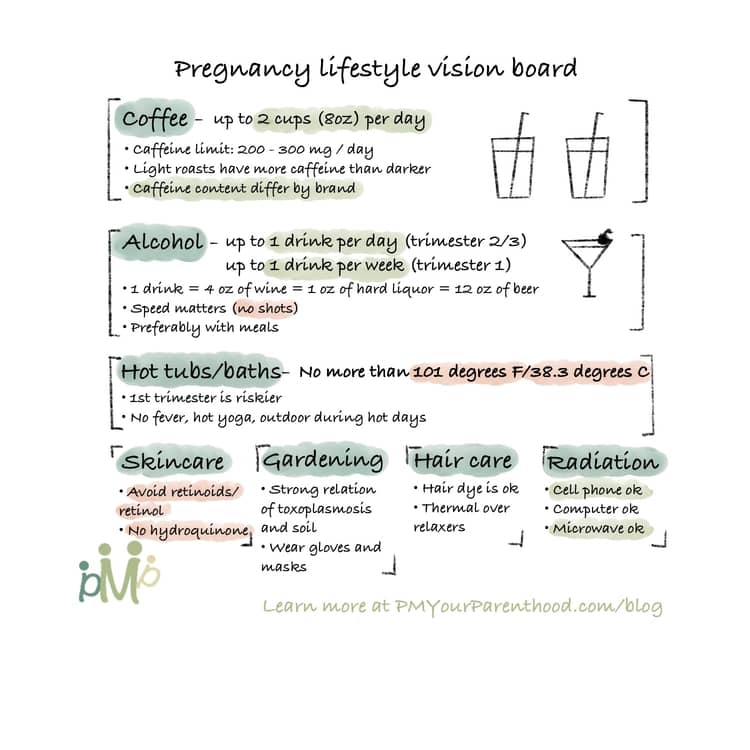Our takeaways:
- A pregnancy lifestyle vision board helps parents-to-be envision their lifestyles during pregnancy, foresee changes, and adapt & adjust in advance.
- It also serves as a collection of the knowledge you’ve learned, the decisions you’ve made, and the guardrails that you will mostly stick to when you actually get pregnant.
Except for those commonly known “hard-no”s for pregnancy (i.e: sushi, raw eggs, tobacco), do you find it difficult to remember HOW MUCH of WHAT you CAN safely have during pregnancy? Do you wonder if there are any “not-so-hard-no”s that are worth your attention? If so, you are not alone.
Of course, your ob will probably give you a list of Dos and Donts anyways when you get pregnant. However, we are talking about lifestyle changes here, which take time and some (or lots of) willpower! You might want to consider creating a vision board to help yourself ease into this new pregnancy lifestyle beforehand and adjust as needed at your own pace.
How does a pregnancy lifestyle vision board help?
A vision board is usually a collage of images, pictures, and affirmations of one’s dreams and desires, designed to serve as a source of inspiration and motivation. A pregnancy lifestyle vision board helps parents-to-be envision their lifestyles during pregnancy, foresee changes, and adapt & adjust in advance.
The pregnancy lifestyle vision board also serves as a collection of the knowledge you’ve learned, the decisions you’ve made, and the guardrails that you will mostly stick to when you actually get pregnant. It provides a reference point for the Team “Parents-to-be” to remind and support each other, and transition into the new lifestyle together smoothly and panic-free.
What to include in a pregnancy lifestyle vision board?
Despite of the safe amount of food intake set by healthcare professionals, pregnancy lifestyle is personal. What I include in my vision board might be different from yours, just like our current lifestyles might differ.

Caffeine
Generally the caffeine recommendation during pregnancy is 200-300 milligrams a day (differ by country, by ob, by book). All available evidence supports up to 2 cups of 8 oz coffee per day, while the majority of the evidence says 3-4 cups is fine. Since caffeine content varies by coffee brand (See a summary table at the end of this article) and by the type of coffee (i.e: brewed vs latte), plus other foods that I consume also contain caffeine (i.e: dark chocolate, coffee ice cream), I feel comfortable to stick to 2 cups of coffee per day. An interesting factor to bake into your calculation: lighter roasts have more caffeine than darker roasts, although the darker roasts have a deeper flavor (Source).
Alcohol
While the general recommendations lean towards no alcohol consumption at all during pregnancy, after reading the data-driven evidence in Expecting Better, I put “up to 1 drink a day in the 2nd and 3rd trimesters, and 1 drink a week in the 1st trimester” on my vision board. (1 drink = 4 ounces of wine = 1 ounce of hard liquor = 12 ounces of beer). Also, note that speed matters! So no shots and preferably drink with meals.
Skincare
Although my current skincare routine is very simple with mostly natural hydration products, I do use topical retinoids (i.e: retinol) from time to time to treat sunspots. Unfortunately, there’s very limited evidence to conclude whether retinoids are safe or not during pregnancy, so my take is to avoid it until further evidence can be found. Other notes: evidence suggests that topical products like salicylic acid, glycolic acid, sunscreen, and self-tanner are safe. One caution is hydroquinone (a skin-lightening product) that is absorbed in significant concentrations. (Source: Expecting Better, Chapter 2).
Hot Tubs/Baths
Elevated temperate in the 1st trimester increases the risk of birth defects like spine bifida. Avoid anything that can increase your body temperature to above 101 degrees Fahrenheit/38.3 degrees Celsius. So no fever, hot tub, very hot baths, hot yoga or even walking outdoors while it’s hot outside.
Gardening
Growing your own vegetables and herbs? Same here! I just started my small garden here in Seattle, with happily growing basils and green onions, as well as baby cilantro and tomatoes. Pay attention to the soil you are handling! Evidence suggests a strong association between toxoplasmosis and soil. Toxoplasmosis is a disease caused by a tiny parasite, which can cause low IQ, vision problems or death of your baby. Wear gloves to garden while pregnant. Consider wearing a mask to avoid inhaling soil particles.
Hair Dye/Straightening
Hair dye is safe after the 1st trimester according to ACOG. However, to straighten your hair, consider thermal re-conditioning processes rather than hair relaxers, the former usually have gentler chemicals. Consult your healthcare provider before action.
Cell phone/Computer screen/Microwave
Worrying about nonionizing radiation? According to CDC, nonionizing radiation from cell phones, computer screens, and microwaves in good condition is not a risk to pregnancy (Source). To play it safe, consider not carrying your phone close to your bump (What to Expect when You’re Expecting, Chapter 3).
Appendix: Caffeine content of brewed coffee by brand (Source)
| Size | Starbucks | McDonald’s | Dunkin Donuts |
| Small | 155 mg caffeine/ 8oz coffee | 109 mg caffeine/ 12oz coffee | 150 mg caffeine/ 10oz coffee |
| Medium | 235 mg caffeine/ 12oz coffee | 145 mg caffeine/ 16oz coffee | 210 mg caffeine/ 16oz coffee |
| Large | 310 mg caffeine/ 16oz coffee | 180 mg caffeine/ 21-24 oz coffee | 300 mg caffeine/ 20oz coffee |
| X-Large | 410 mg caffeine/ 20oz coffee | 359 mg caffeine/ 24oz coffee |
Like this article? Share it with your loved ones! To get bite-size parenthood wisdom like this, or save infographics for future references, follow us on Instagram (@PMYourParenthood)!
Check out more blogs here!
Also you can support me and my work by contributing a cup of coffee here:


